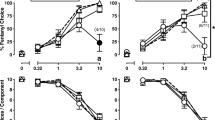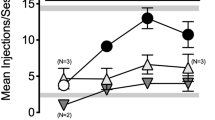Abstract
The ability of mu and kappa opioids to alter the discriminative-stimulus and rate-decreasing effects of the 5-HT1A receptor agonist 8-OH-DPAT was examined in rats trained to discriminate either a low (0.1 mg/kg) or a high (0.3 mg/kg) dose of 8-OH-DPAT from water using a two-lever food-reinforced drug discrimination procedure. The mu opioids, morphine and fentanyl, and the kappa opioids, U50,488 and bremazocine, failed to substitute for the 8-OH-DPAT stimulus, even when tested up to doses that substantially reduced rates of responding. During antagonism tests, selected doses of the mu opioids, morphine and fentanyl, administered at various pretreatment times, attenuated the stimulus effects of both training doses of 8-OH-DPAT. Moreover, morphine (135-min pretreat) and fentanyl (15-min pretreat) produced rightward shifts in the 8-OH-DPAT dose-effect curve that were partially surmountable and naltrexone-reversible. In contrast to the effects of the mu opioids, the kappa opioids, U50,488 and bremazocine, failed to alter the stimulus effects of the training dose of 8-OH-DPAT, regardless of dose or pretreatment time. The ratedecreasing effects of 8-OH-DPAT were not altered substantially by either the mu or kappa opioids examined. The present study demonstrates that the stimulus effects, but not the rate-decreasing effects, of 5-HT1A receptor agonists can be modulated by mu opioids, whereas neither of these effects are changed by kappa opioids.
Similar content being viewed by others
References
Ahtee L, Attila LM, Carlson KR, Haikala H (1989) Changes in brain monoamine metabolism during withdrawal from chronic oral self-administration of morphine and in response to a morphine challenge in the withdrawn state. J Pharmacol Exp Ther 249: 303–310
Alhaider AA, Wilcox GL (1992) Differential roles of 5-hydroxytryptamine1A and 5-hydroxytryptamine1B receptor subtypes in modulating spinal nociceptive transmission in mice. J Pharmacol Exp Ther 265: 378–385
Arnt J (1989) Characterization of the discriminative stimulus properties induced by 5-HT1 and 5-HT2 agonists in rats. Pharmacol Toxicol 64: 165–172
Berge O, Hole K, Ogren S (1983) Attenuation of morphine-induced analgesia byp-chlorophenylalanine andp-chloroamphetamine: test-dependent effects and evidence for brainstem 5-hydroxytryptamine involvement. Brain Res 271: 51–64
Berge O, Fasmer OB, Ogren SO, Hole K (1985) The putative serotonin receptor agonist 8-hydroxy-2-(di-n-propylamino)tetralin antagonizes the antinociceptive effect of morphine. Neurosci Lett 54: 71–75
Bronson ME, Lin Y, Burchett K, Picker MJ, Dykstra LA (1993) Serotonin involvement in the discriminative stimulus effects of K opioids in pigeons. Psychopharmacology 111: 69–77
Browne RG, Welch WM (1982) Stereoselective antagonism of phencyclidine's discriminative properties by adenosine receptor agonists. Science 217: 1157–1159
Cui Y, Lee TF, Kramarova LI, Wang LCH (1993) The modulatory effects of mu and kappa opioid agonists on 5-HT release from hippocampal and hypothalamic slices of euthermic and hibernating ground squirrels. Life Sci 53: 1957–1965
Cunningham KA, Callahan PM, Appel JB (1987) Discriminative stimulus properties of 8-hydroxy-2-(di-n-propylamint)tetralin (8-OHDPAT): implications for understanding the actions of novel anxiolytics. Eur J Pharmacol 138: 29–36
Doty P, Dykstra LA, Picker MJ (1994) Discriminative stimulus effects of phencyclidine: pharmacologically specific interactions with delta-9- and delta-8-tetrahydrocannabinol. Drug Alcohol Depend 35: 151–158
Dykstra LA, Doty P, Johnson AB, Picker MJ (1992) Discriminative stimulus properties of cocaine, alone and in combination with buprenorphine, morphine and naltrexone. Drug Alcohol Depend 30: 227–234
Emmett-Oglesby MW, Herz A (1987) Opioid modulation of the discriminative stimulus produced by pentylenetetrazol. Psychopharmacology 92: 313–319
Fozard JR, Mir AK Middlemiss DM (1987) The cardiovascular response to 8-hydroxy-2-(di-n-propylamino) tetralin (8-OH-DPAT) in the rat: site of action and pharmacological analysis. J Cardiovasc Pharmacol 9: 328–347
Gauvin DV, Young AM (1989) Evidence for perceptual masking of the discriminative morphine stimulus. Psychopharmacology 98: 212–221
Glaser T (1988) Ipsapirone, a potent and selective 5HT1A receptor ligand with anxiolytic and antidepressant properties. Drugs of the Future 13: 429–439
Glennon RA (1986) Discriminative stimulus properties of the 5-HT1A agonist 8-hydroxy-2-(di-n-propylamino)tetralin (8-OH-DPAT) Pharmacol Biochem Behav 25: 135–139
Goodwin GM, De Souza RJ, Green AR (1986) The effects of a 5HT1 receptor ligand ipsapirone (TVX Q 7821) on 5-HT synthesis and the behavioural effects of 5-HT agonists in mice and rats. Psychopharmacology 89: 382–387
Grauer SM, Tao R, Auerbach SB (1992) Morphine induces an increase in extracellular serotonin in the rat diencephalon. Brain Res 599: 277–282
Gulati A, Bhargava HN (1990) Down-regulation of hypothalamic 5-HT1A receptors in morphine-abstinent rats. Eur J Pharmacol 182: 253–259
Harris CM, Emmett-Oglesby MW, Mathis DA, Lal H (1988) Quantal detection and homogeneous sensitivity in a pentylenetetrazol discrimination. Psychopharmacology 94: 183–187
Hirschhorn ID, Rosecrans JA (1974) A comparison of the stimulus effects of morphine and lysergic acid diethylamide (LSD) Pharmacol Biochem Behav 2: 361–366
Hjorth S, Carlsson A, Lindberg P, Sanchez D, Wikstrom H, Arvidson L-E, Hacksel U, Nilson JLG (1982) 8-Hydroxy-2-(di-n-propylamino) tetralin, 8-OH-DPAT, a potent and selective simplified ergot congener with central 5-HT-receptor stimulating activity. J Neural Transm 55: 169–188
Ho BY, Takemori AE (1989) Serotonergic involvement in the antinociceptive action of and the development of tolerance to the kappa-opioid receptor agonist, U-50,488H. J Pharmacol Exp Ther 250: 508–514
Ho BY, Takemori AE (1990a) Attenuation of the antinociceptive action of the selective k-opioid receptor agonist, U-50,488H by ICS-205-930. Eur J Pharmacol 178: 371–373
Ho BY, Takemori AE (1990b) Release by U-50,488H of [3H]serotonin from brain slices and spinal cord synaptosomes of U-50,488H-tolerant and nontolerant mice. J Pharmacol Exp Ther 254: 8–12
Holtzman SG (1991) Discriminative stimulus effects of spiradoline, a kappa-opioid agonist. Psychopharmacology 105: 447–452
Joharchi N, Sellers EM, Higgins GA (1993) Effect of 5-HT3 receptor antagonists on the discriminative stimulus properties of morphine in rats. Psychopharmacology 112: 111–115
Kamien JB, Spealman RD (1991) Modulation of the discriminative-stimulus effects of cocaine by buprenorphine. Behav Pharmacol 2: 517–520
Mariathasan EA, Stolerman IP (1993) Overshadowing of nicotine discrimination in rats: a model for behavioural mechanisms of drug interactions? Behav Pharmacol 4: 209–215
Mathis DA, Emmett-Oglesby MW, Harris CM, Lal H (1987) Quantal nature of generalization and acquisition responding by rats in a drug discrimination task. Psychol Rec 37: 161–165
Matos FF, Rollema H, Brown JL, Basbaum AI (1992) Do opioids evoke the release of serotonin in the spinal cord? An in vivo microdialysis study of the regulation of extracellular serotonin in the rat. Pain 48: 439–447
Millan MJ, Colpaert FC (1990) Attenuation of opioid induced antinociception by 5-HT1A partial agonists in the rat. Neuropharmacology 29: 315–318
Millan MJ, Colpaert FC (1991a) 5-Hydroxytryptamine (HT)1A receptors and the tail-flick response. II. High efficacy 5-HT1A agonists attenuate morphine-induced antinociception in mice in a competitive-like manner. J Pharmacol Exp Ther 256: 983–992
Millan MJ, Colpaert FC (1991b) 5-Hydroxytryptamine (HT)1A receptors and the tail-flick response. III. Structurally diverse 5-HT1A partial agonists attenuate mu- but not kappa-opioid antinociception in mice and rats. J Pharmacol Exp Ther 256: 993–1001
Nader MA, Woolverton WL (1994) Blockade of the discriminative stimulus effects ofd-amphetamine in rhesus monkeys with serotonin 5-HT1A agonists. Behav Pharmacol 5: 591–598
Nakazawa T, Yamanishi Y, Kaneko T (1991) A comparative study of monoaminergic involvement in the antinociceptive action of E-2078, morphine and U-50,488H. J Pharmacol Exp Ther 257: 748–753
Niwa M, Nose T, Nozaki M, Tsurumi K, Fujimura H (1985) Effects of butorphanol and its metabolites on the levels of monoamines and their metabolites in the rat brain. Jpn J Pharmacol 39: 515–528
Passarelli F, Costa T (1989) Mu and delta opioid receptors inhibit serotonin release in rat hippocampus. J Pharmacol Exp Ther 248: 299–305
Picker MJ, Doty P, Negus SS, Mattox SR, Dykstra LA (1990) Discriminative stimulus properties of U50,488 and morphine: effects of training dose on stimulus substitution patterns produced by mu and kappa opioid agonists. J Pharmacol Exp Ther 254: 13–22
Piesla MJ, Marquis KL (1994) WAY-100635: a potent 5-HT1A antagonist that blocks the discriminative stimulus and response rate effects of 8-OH-DPAT in rats. Soc Neurosci Abstr 20: 377
Powell KR, Picker MJ, Dykstra LA (1994) Serotonin involvement in the discriminative stimulus effects of mu and kappa opioids in rats. Behav Pharmacol 5: 255–264
Rosecrans JA, Goodloe Jr MH, Bennett GJ, Hirschhorn ID (1973) Morphine as a discriminative cue: effects of amine depletors and naloxone. Eur J Pharmacol 21: 252–256
Sanger DJ, Schoemaker H (1992) Discriminative stimulus properties of 8-OH-DPAT: relationship to affinity for 5HT1A receptors. Psychopharmacology 108: 85–92
Sewell RDE, Spencer PSJ (1975) Anti-nociceptive activity of narcotic agonists and partial agonists in mice given biogenic amines by intracerebroventricular injection. Psychopharmacologia 42: 67–71
Shannon HE, Holtzman SG (1979) Morphine training dose: a determinant of stimulus generalization to narcotic antagonists in the rat. Psychopharmacology 61: 239–244
Smith LM, Peroutka SJ (1986) Differential effects of 5-hydroxytryptamine1A selective drugs on the 5-HT behavioural syndrome. Pharmacol Biochem Behav 24: 1513–1519
Spealman RD, Bergman J (1992) Modulation of the discriminative stimulus effects of cocaine by mu and kappa opioids. J Pharmacol Exp Ther 261: 607–615
Swedberg MDB, Shannon HE, Nickel B, Goldberg SR (1992) D-16949 (Anpirtoline): a novel serotonergic (5-HT1B) psychotherapeutic agent assessed by its discriminative effects in the rat. J Pharmacol Exp Ther 263: 1015–1022
Tang AH, Franklin SR (1991) The discriminative stimulus effects of diazepam in rats at two training doses. J Pharmacol Exp Ther 258: 926–931
Tricklebank MD, Neill J, Kidd EJ, Fozard JR (1987) Mediation of the discriminative stimulus properties of 8-hydroxy-2-(di-n-propylamino)tetralin (8-OH-DPAT) by the putative 5-HT1A receptor. Eur J Pharmacol 133: 47–56
Von Voigtlander PF, Lewis RA, Neff GL, Triezenberg HJ (1983) Involvement of biogenic amines with the mechanisms of novel analgesics. Prog Neuropsychopharmacol Biol Psychiatry 7: 651–656
Von Voigtlander PF, Lewis RA, Neff GL (1984) Kappa opioid analgesia is dependent on serotonergic mechanisms. J Pharmacol Exp Ther 231: 270–274
Winter JC, Rabin RA (1992) Yohimbine as a serotonergic agent: evidence from receptor binding and drug discrimination. J Pharmacol Exp Ther 263: 682–689
Winter JC, Rabin RA (1993) Antagonism of the stimulus effects of yohimbine and 8-hydroxydipropylaminotetralin. Pharmacol Biochem Behav 44: 851–855
Young AM (1991) Discriminative stimulus profiles of psychoactive drugs. Adv Subst Abuse 4: 139–203
Young AM, Masaki MA, Geula C (1992) Discriminative stimulus effects of morphine: effects of training dose on agonist and antagonist effects of mu opioids. J Pharmacol Exp Ther 261: 246–257
Zhang L, Barrett JE (1991) Imipramine as a discriminative stimulus. J Pharmacol Exp Ther 259: 1088–1093
Author information
Authors and Affiliations
Rights and permissions
About this article
Cite this article
Morgan, D., Picker, M.J. Discriminative stimulus effects of the 5HT1A agonist 8-OH-DPAT: attenuation by mu but not by kappa opioids. Psychopharmacology 122, 336–345 (1995). https://doi.org/10.1007/BF02246263
Received:
Revised:
Issue Date:
DOI: https://doi.org/10.1007/BF02246263




